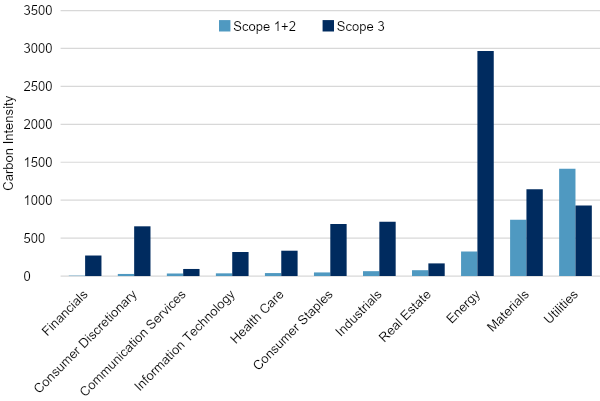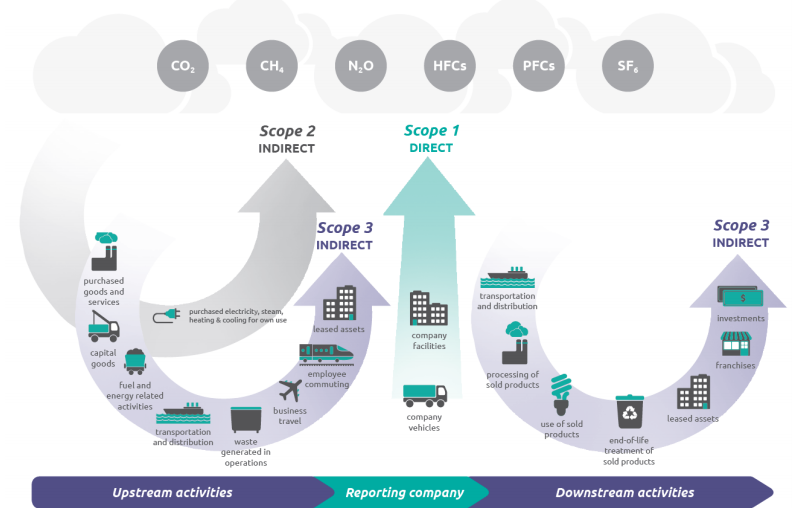This is the final blog in a series on index innovation for net zero. The first blog, Journey to Net Zero with the S&P PACT™ Indices, discusses how a combination of groundbreaking new datasets and index innovation is emerging. The second blog, “Let’s Get Physical” With S&P Trucost’s Physical Climate Risk Data, looks at how technological advances are paving the way for granular assessments of physical risk exposure. The third blog, A Declaration of Importance: Climate Risk Is Real, but Paris Alignment Data Can Help Us Solve It, considers new datasets and index innovations that are catalyzing an investor-led revolution to reorient capital flows towards net zero emissions. We now discuss the importance of tracking GHG emissions from Scope 3.
Responsible investing means investing responsibly, but what exactly are we responsible for? Climate change, of course, is high on the agenda, prompting one fifth (21%) of the world’s 2,000 largest publicly-listed companies to pledge net zero commitments by 2050.1 However, only one third of these are believed to include Scope 3 emissions, defined by the Greenhouse Gas Protocol as including all indirect emissions that occur in the company’s value chain.2 In fact, the greatest share of greenhouse gas (GHG) emissions comes from Scope 3 sources, culpable for as much as 90% among certain types of companies.3 Our tendency to omit such swathes of the value chain not only invites criticisms of greenwashing, but could also expose us to a costly mispricing of assets (never mind the climate impacts). Being ‘responsible’, it seems then, means going beyond the targets and assuming accountability for all financed emissions, to which Scope 3 is by no means exempt. Besides, as the adage goes, we must first measure before we can manage.
Exhibit 1: Sector Breakdown of Scope 1+2 and Scope 3 Emissions

Source: S&P Global. Data as of December 2020. For illustrative purposes only.
So, what exactly is Scope 3 data and how can it be measured? The GHG Protocol classifies a company’s GHG emissions into three Scopes. Scope 1 refers to direct emissions from owned or controlled sources, i.e., those emitted from the day-to-day operations of a company in the production process. Scope 2 refers to indirect emissions from purchased energy, i.e., the implied emissions to support a company’s electricity consumption via the grid. And finally, Scope 3 emissions are indirect emissions (not included in Scope 2) embedded throughout a company’s value chain. These can be upstream, such as the indirect emissions fueled by a company’s supply chain, or downstream, via the emissions generated by the use of a company’s products and services.4 All Scopes are key to measuring a company’s overall footprint and, in some cases, Scope 3 may matter more as its share of emissions is not the same across sectors. From an investor’s perspective, not including Scope 3 emissions thus poses climate transition risks that ought to be managed.
What about the issues of double counting caused by incorporating Scope 3 emissions? The EU Technical Expert Group on Sustainable Finance does not recommend any management of double counting,5 since the same amount of emissions may be considered as a proxy, even if imperfect, for financial risks related to climate change, even if counted several times. The risk reduction objective of investors using climate benchmarks also supports a basis for not managing double counting. In other words, better safe than sorry.
Exhibit 2: Overview of GHG Protocol Scopes & Emissions

Source: GHG Protocol: Greenhouse Gas Protocol Corporate Value Chain (Scope 3) Standard.
Our approach rests upon S&P Global Trucost’s leading methodology for quantifying the environmental impacts of companies’ business activities. Renowned for high-quality climate data and analytics, Trucost has pioneered climate investing at the nexus of natural capital accounting and capital allocation decisions for more than two decades. What is particularly unique about the approach is Trucost’s proprietary Environmentally-Extended Input Output (EEIO) model. This extends traditional economic input-output modeling (defining the ratio of expenditure from one sector across all sectors) to account for the known environmental impacts associated with given units of production (e.g., tCO2e per metric ton of crude steel).
Moreover, we apply this at hyper-granular levels of segmentation, breaking down global economic activity to 464 sub-industries that are as detailed as paper versus cardboard manufacturing. As such, even if companies do not disclose the environmental profile of their activities, we can still derive their likely Scope 1, Scope 2 and Scope 3 emissions (among other environmental impacts) by overlaying these environmental-intensity factors on a company’s known quantities of production, where possible, and weighting these by revenue source for companies with diversified business models. Indeed, we apply this across a company’s own operations and across their entire supply chain, including primary resource extraction, secondary processing and final product assembly, to cover all upstream Scope 3 categories from cradle to gate. For downstream impacts, our approach utilizes CDP’s collected data, for which respondents can provide emissions for: downstream transportation and distribution, processing of sold products, use of sold products, end-of-life treatment of sold products, downstream leased assets, franchises, investments and any other applications the company might deem applicable.6
Exhibit 2: Quantifying Downstream Scope 3 Emissions

Source: S&P Global Trucost. For illustrative purposes only.
The modeled metrics are only the starting point. As climate-related reporting is spotty at best, they serve as a robust and comprehensive basis for sense-checking corporate disclosure. A company’s reported data is used without adjustment if and only if it is third-party verified and all relevant categories are calculated.7 Where there are data gaps, the model also serves as a stopgap to ensure universal coverage. This is essential for proper index construction and other investment use cases to align with a net zero pathway (7% year-on-year), as with our S&P PACT Indices. Indeed, as with any investment strategy, the results are only as good as the quality of the underlying inputs. Thus, in a world where greenwashing runs rampant and time is of the essence, such scientific bases for capturing all manner of emissions – from Scope 1 to 3 – remain indispensable in our fight against climate change.8
1 “TAKING STOCK: A global assessment of net zero targets”, University of Oxford, March 2021, https://racetozero.unfccc.int/wp-content/uploads/2021/06/ECIU-Oxford_Taking_Stock.pdf.
2 Greenhouse Gas Protocol Corporate Value Chain (Scope 3) Standard: https://ghgprotocol.org/standards/scope-3-standard
3 “Scope 3 and the supply chain: How businesses are taking sustainability leadership to a new frontier”, Edie, August 5, 2020, www.edie.net/library/Supply-chain-emissions--The-next-frontier-of-sustainable-business-leadership/6982.
4 To learn more about the GHG Protocol’s approach to classifying Emissions Scopes, refer to: https://ghgprotocol.org/sites/default/files/standards_supporting/FAQ.pdf).
5 Report on Benchmarks”, EU Technical Expert Group on Sustainable Finance, September 2019, https://ec.europa.eu/info/sites/default/files/business_economy_euro/banking_and_finance/documents/190930-sustainable-finance-teg-final-report-climate-benchmarks-and-disclosures_en.pdf.
6 Trucost considers all 15 of the upstream and downstream categories outlined by the GHG Protocol Corporate Value Chain Accounting Standard, to align with industry best practices.
7 Trucost also engages annually with all the 14,000+ companies being covered (capturing 99% of global market capitalization) for additional verification, giving companies the opportunity to dispute any discrepancies, assuming they substantiate their claims with third-party verified documentation.
8 For more information on the S&P Global Trucost Methodology for Assessing Scope 3 Emissions Data, please refer to our methodology document available here: www.marketplace.spglobal.com/en/datasets/trucost-environmental-(46).
Learn more about how "The Quality Imperative" differentiates our essential sustainability intelligence.
READ MORE >-
Discover multiple layers of ESG insight.
Learn more -
Get comprehensive company analytics and best practice reporting solutions.
Learn more -
Optimize the climate, ESG and impact performance of your investment portfolio.
Learn more
We’re here to help you accelerate your sustainability journey. Get connected with an ESG specialist who can advise you on your next steps.
Talk To An Expert


